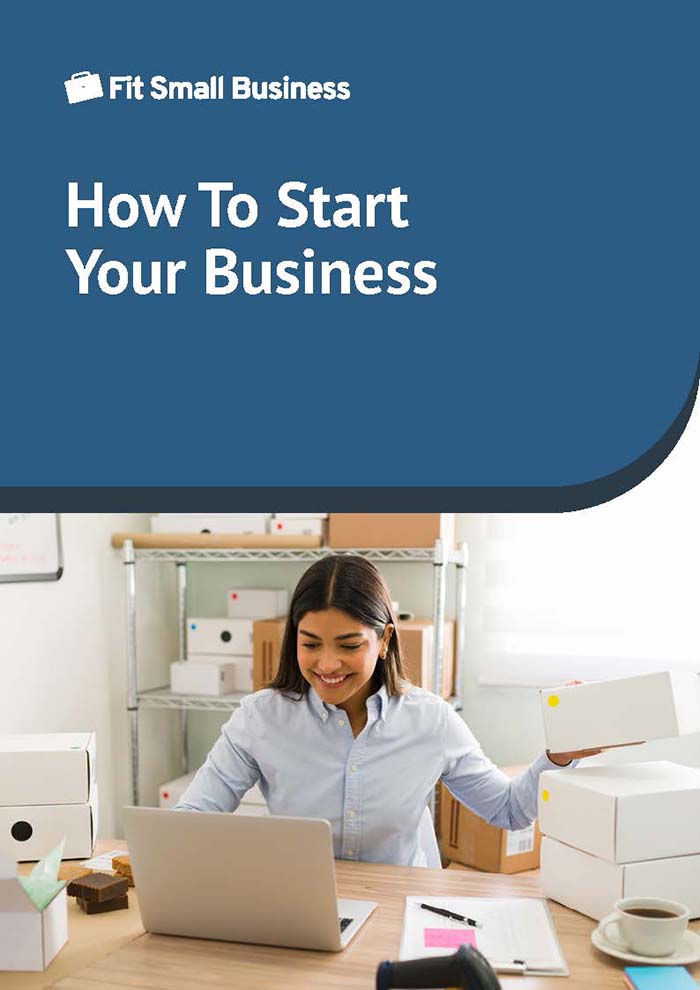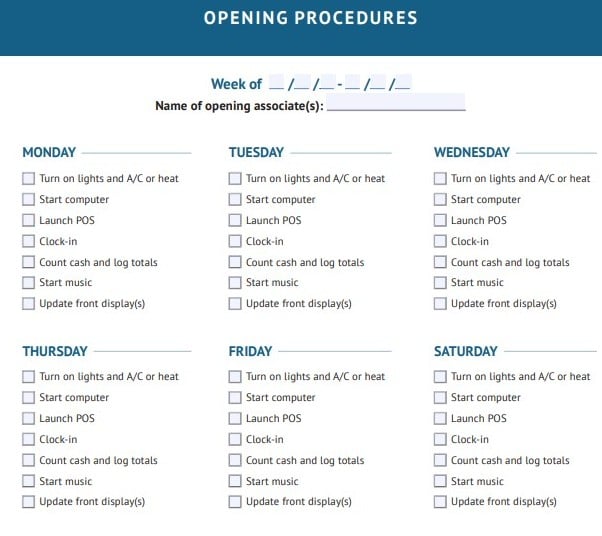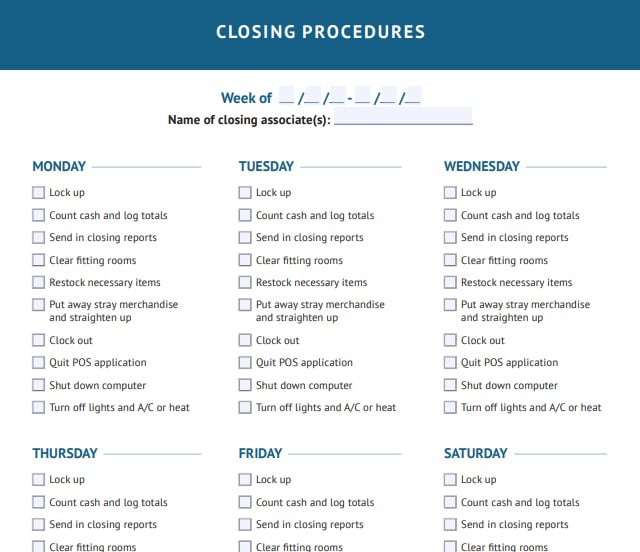To open a successful brick-and-mortar store, you need a business plan (including market research) and legal structure for your business, an ideal storefront location, startup funding, inventory, and a team of employees ready to start selling. Plus, in today’s market, you’ll also want to launch an accompanying online store and start marketing your business.
As you're starting your own business, you're going to need to keep your books in order. QuickBooks Online is our pick for the best overall small business accounting software. Get 50% Off for 3 Months |
|
Learn how to start a retail business in 13 simple steps:
Step 1: Create a Retail Store Business Plan
A business plan is a written document containing the goals of a business, the methods for attaining those goals, and the time frame for the achievement of the goals. It is what you present to potential investors and a crucial first step for starting any business. Not only that, writing a business plan gives you a definitive path to follow, ensures you’ve done proper market research, and sets you up for success.
The Small Business Administration (SBA) outlines two types of business plans: traditional and lean startup.
- Traditional business plans are more thorough and ideal if you’re requesting funding from banks or other traditional loan sources.
- Lean startup business plans are more informal and designed for businesses that are more fluid and will change a lot as they grow.
You can also create a shorter, one-page business plan. Learn how with our one-page business plan guide.
When opening a retail store, we recommend following a traditional business plan as it’s more detailed—it can never hurt to be too prepared. Plus, it will provide a more concrete outline for you and your business partners or possible investors.
The nine elements of a traditional business plan are:
- Executive summary: High-level paragraph outlining your company’s purpose, mission, and why it will be successful.
- Company description: Be specific about your company’s details, including what problem you are aiming to solve, how you will solve it, what consumers you plan to serve, and the talent on your team.
- Market analysis: Include industry outlook and trends, what successful competitors are doing, and what your strengths will be.
- Organization and management: Outline who will be running your business and the experience your team members have in retail or startup environments.
- Product line: Outline what kinds of products you will sell, why they are needed, and include any research and development on private labels or proprietary custom products.
- Marketing and sales: Describe the tactics you will use to obtain and retain customers.
- Funding requests: If you need outside funding, outline your needs and specify exactly how you will use the funds.
- Financial projections: Detail how your business will become stable and profitable, including a projected financial timeline of at least five years.
- Appendix: Use this space for any supplemental documents, such as product prototypes and pictures, credit histories, licenses, and permits.
This may seem like a lot of information, but it’s best to keep each section succinct so readers can easily get through the entire document and absorb all of the information.
Be sure you are answering the “why” behind the “how” of starting a retail business. Why are the strategies you selected for achieving your business plan the best? Why will they work?
When it comes to actually writing and formatting your business plan, there are a few different options to choose from. Of course, you can type it out in traditional word processing software like Microsoft Word or Google Docs. You can also build your business plan as a slideshow in PowerPoint, which is a great option if you need to present your plan to an audience.
There are also business plan software tools available, such as LivePlan, that have industry-specific templates. You can also use this business plan template and checklist or enlist the help of business plan writing services.
Step 2: Determine Your Niche & Select Products
A niche is the subset of the market to whom your business and products seek to appeal. This subset can be defined by its own unique needs, preferences, or identity that makes it different from the market at large. Your niche will define the products you sell, your price range, product quality, and marketing initiatives.
The narrower your niche market, the easier it is to become the go-to retail destination for that market. For example, there may be a dozen stores in town that sell pet products, but you may be the only retailer that specializes in dog costumes or organic food options.
Carving out a niche for your retail store helps differentiate your business from the competition. With retail giants like Amazon and Walmart, the competition is fiercer than ever. And truthfully, many large retailers, like department and box stores, carry very similar products. Aside from the feel-good nature of shopping small, having something unique to offer will help you beat out big box retailers.
You can find your niche market by:
- Listing your hobbies and interests
As a store owner, you will spend a lot of time engulfed in your chosen niche, so your own interests are a good place to start. Plus, choosing something you’re interested in will make your store more authentic.
- Researching the potential for each niche
Make sure you choose a topic that has good money-making potential by doing research on Google Trends and checking out competitors on social media.
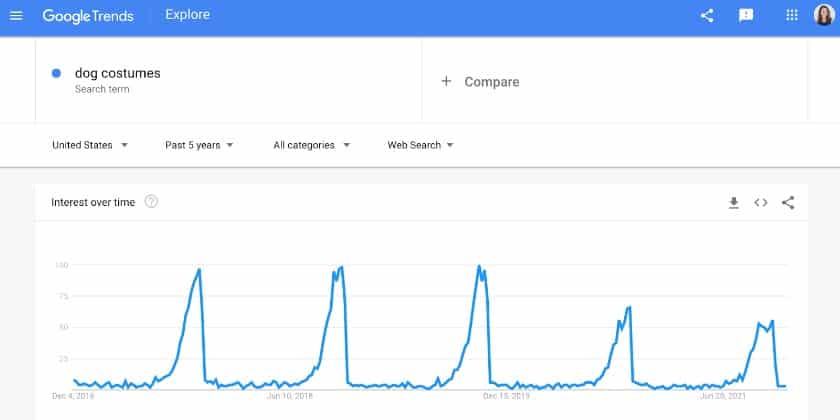
The phrase “dog costumes” appear to be trending downward in search, indicating a different niche may present a more long-term opportunity.
- Evaluating potential profits
Determine how profitable each niche could be by looking at industry statistics and Amazon Best Seller lists to see what sales are like for your chosen categories. You can also research wholesale prices for products on sites like Alibaba and compare them to typical retail prices to get a sense of potential profit margins.
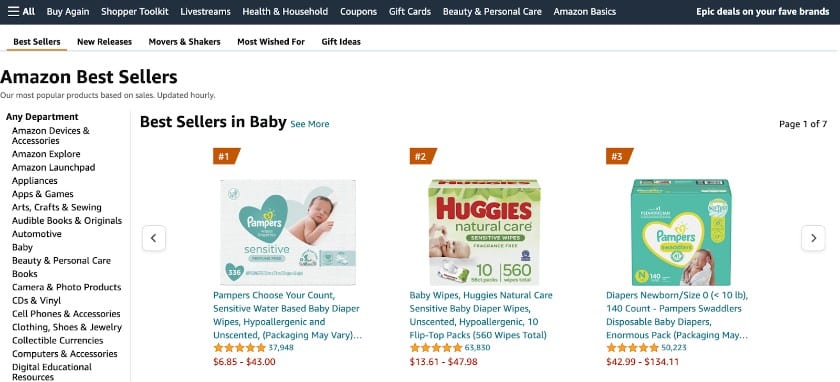
Amazon Best Sellers lists highlight popular products by category.
Sourcing Products From Suppliers
Once you’ve narrowed in on your niche products, it’s time to find a reliable supplier for those products. When figuring out how to source products for your retail business, you’ll first need to understand the different options.
- Manufacturer: You develop the product concept and outsource the creation. This option allows for the most control over the product but also takes comparatively long.
- Wholesaler: Wholesalers develop products and sell them in bulk to retailers for a discounted price. Retailers then resell those items for a profit. This is the quickest route for product sourcing, but it also allows for the least control over the product.
- Dropship: Dropshipping is when you sell products directly to customers and then outsource the manufacturing and fulfillment for each order. It is the most hands-off option, but also yields the lowest profit margins.
In the news:
As we know, inflation is a major consideration for both retailers and consumers in the post-pandemic era. However, the National Retail Federation has been putting pressure on the current administration to lower tariffs on everyday items to help lower inflation. In response, President Biden recently signed the Ocean Shipping Reform Act, which aims at improving maritime trade practices and lowering supply chain costs.
When choosing your supplier, research a few different options and order samples from two to five suppliers. Undergo quality assurance testing to narrow down which items you want to source. From there, nurture vendor relationships with effective communication and efficient payment—eventually, you can negotiate discounts, especially for high-volume orders.
The COVID-19 pandemic brought many challenges to supply chains all over the world, and many suppliers are still seeing its effects. As a retailer, you can plan for these issues by padding timelines, vetting suppliers, having multiple sources for your most popular products, and choosing local suppliers when possible.
Retail Market Research
Instead of starting with niche products and then researching to find their market, you can also start by doing primary market research. This is a type of market research where you go straight to your target consumers and ask them questions to figure out their interests. In other words, you are starting with your consumer and their needs rather than starting with a product and then finding the right audience.
When you’re opening a physical brick-and-mortar storefront, you can study your local audience directly to determine their needs. It’s possible, and likely, that there are some specific needs locals have that your store can fill.
Effective primary market research tactics include:
Step 3: Develop Your Brand
Your products are just one part of your retail business. Developing a brand or your business’ identity is also important because it attracts new customers and builds strong relationships with existing ones. Your brand identity is the essence of who you are as a store—it creates the feel that customers associate with your business and maintains cohesiveness between your products and aesthetic.
You only get seven seconds to make a first impression, but it takes up to seven impressions to create brand awareness. Read about this and more in our article on Branding Statistics Every Small Business Should Know.
When defining your brand, ask yourself what feelings you want your business to evoke. Tap into your market research—look at who your biggest competitors are and think about what their branding looks like and how you can differentiate your store from theirs. All of this information helps build the foundation of your brand.
Elements of your brand include:
- Visual branding such as logo, storefront, fonts, signage, and colors.
- Store name and slogan that are completely unique to you.
- Mission statement and vision statement that outline how you want to serve your community and customers.
- Positioning in your niche, market, community—and what sets you apart from the competition.
Step 4: Choose a Legal Structure for Your Retail Business
Choosing a legal structure for your business is important because it determines how to collect and report taxes, how you’ll get paid from your business, and your level of personal liability. There are many types of legal structures, but the three most commonly found in retail are sole proprietorships, limited liability companies (LLCs), and corporations.
Step 5: Organize Your Finances
Regardless of which legal structure you choose, it’s critical to separate your business finances from your personal accounts right from the beginning. Having a dedicated business account will make it much easier to track expenses and income, which will help you stay on track financially. Plus, you’ll have an easier time filing your taxes. Not to mention, if your personal and business finances are combined, that could “pierce the corporate veil” of your LLC if things go wrong.
When it comes to choosing a small business checking account, the options are virtually unlimited. Look for a bank that’s small business-friendly with few fees. Make sure there are branches close to your store or home. As a retailer, you’ll likely be making many cash deposits and making change, so getting to the bank should be convenient.
Consider other features that will make your life easier, such as mobile banking and online check deposit. Also, consider whether or not the bank has features that will help as your business grows, such as business credit accounts, loans, and overall branch location accessibility.
To get help choosing the best small business banking solutions for your business, check out the following guides:
In addition to a small business checking account, you’ll also want to have an accounting software program. There are a lot of expenses associated with running a retail store, such as products and shipping, employee wages, and advertising costs. Accurately tracking your income and expenses will help you see exactly how much revenue you’re making, understand where your expenses are high, determine your product purchasing budget, and make filing taxes a million times easier.
QuickBooks is one of our favorite accounting programs for small businesses because it is affordable, user-friendly, and integrates with many popular retail point-of-sale (POS) systems (we’ll cover POS systems below). It’s particularly good for retailers because it has retail-specific report bundles available—including reports like gross margin by inventory volume—and integrates with ecommerce solutions. QuickBooks plans start at just $10 per month, plus they offer a free 30-day trial.
Step 6: Launch Your Online Store
While you might be opening a physical retail store, in today’s market, you will also want to launch an accompanying digital storefront. Your bottom line has a lot to gain from launching an online store—in tandem with your retail store, it can help you reach a larger audience, geographically speaking, and it also gives you another channel where you can nurture existing customer relationships.
Forecasters from eMarketer expect multichannel sales to make up close to 46% of all ecommerce sales by 2023, up from 40% in 2019. This 46% will amount to more than $585 billion in sales—and those are sales you don’t want to miss.
To start with the launch of your online store, you will first need to choose an ecommerce platform that integrates with your POS system and accounting software. Most modern ecommerce platforms have templates and tools to help you design your store, or you can hire a professional to help.
We recommend Shopify as the top, user-friendly, high-value ecommerce platform. Not only that, every Shopify ecommerce subscription comes with a Shopify POS system for seamless integration.
From there, you will want to get your order fulfillment and shipping figured out so that you can get customers their orders.
You should also consider offering click-and-collect services for your local customers. At the onset of the pandemic, buy online, pick up in-store (BOPIS) increased from 15% of orders to 25%, a 65% share increase, and this BOPIS momentum doesn’t look like it’s slowing down anytime soon.
Not sure where to start with your ecommerce site? We put together an entire guide to take you through how to start an online store. You can also check out these resources:
Step 7: Secure Funding for Your Retail Store
Opening a retail store requires a lot of upfront investment. You need to sign a lease on a physical space, invest in renovating that space, purchase products, set up your POS system and payment processing hardware, advertise like crazy, invest in a grand opening, and pay staff. It sounds expensive because it is expensive. Altogether, opening a retail store can cost up to $100,000.
To fund your retail store, ideally, you have a decent chunk of your upfront costs saved that you can invest personally. But, there are also plenty of small business funding options where you can secure capital from external sources.
Some of those options include:
- Small business loans: You find these loans from banks, credit unions, the SBA, and even your existing network of connections. This is where your formal business plan will come into play—it shows investors your path to success (and to getting a return on their investment).
- Credit cards: If you’re just starting out and have no business income history, or if you have a lower credit score, choosing a business credit card may be the better option. A credit card will also give you more flexibility to account for unexpected expenses. Visit our guide on the best small business credit cards to see which one may be right for you.
- Crowdfunding: Crowdfunding is a great way to build buzz for your store and get people financially and personally invested in it. Plus, you don’t need to pay this money back.
The biggest factors to consider when taking out a loan are the interest rates (AIRs), upfront fees, and application requirements. Typical AIRs vary based on your loan type but should look something like this:
Business Loan Interest Rates | Average Annual Interest Rate (AIR) | Minimum AIR | Medium AIR | Maximum AIR | Average Loan Amount |
|---|---|---|---|---|---|
New Fixed-rate Loans | 2.54% | 0.47% | 2.73% | 7.65% | $59,046 |
New Variable-rate Loans | 3.90% | 1.09% | 4.25% | 6.25% | $319,117 |
Outstanding Fixed-rate Loans | 2.69% | 1.00% | 2.89% | 8.02% | $59,716 |
Outstanding Variable-rate Loans | 4.19% | 1.84% | 4.68% | 7.50% | $159,243 |
Source: ValuePenguin | |||||
An alternative option for funding your business is using your IRA or 401(k) retirement account. Your initial reaction to this idea may be, “Whoa, absolutely not.” But, using your retirement account to fund your business doesn’t necessarily mean you’re cashing out or borrowing against your account.
Instead, there’s an option called Rollover for Business Startups (ROBS), which lets you invest retirement funds into your new business without paying taxes or early withdrawal penalties. This process can be complicated. So, if you’re interested in using your retirement account to fund your business, we recommend working with an experienced provider like Guidant.
Step 8: Choose a Storefront Location to Open Your Retail Store
Choosing a location for your business can seem overwhelming: Where do you start? How do you know if you’re choosing a profitable area? Will people even want to come to your location?
When choosing a location for your business, narrow down your options first based on practicality and convenience. Consider how far you’re realistically willing to commute every day for the foreseeable future. Choose areas that are easily accessible from your residence. Spend time in each area to become familiar with specific neighborhood demographics and preferences and to scope out other local businesses.
From there, you can start looking at listings in your desired area and finding a space that will work for you and your needs. Contacting listings directly can offer the best deal; however, working with a real estate agent will give you peace of mind in the contract negotiations and help you find the best space for your business.
Learn more in our guide on how to find and lease retail space, which includes different types of leases, terms to be aware of, and how to calculate your monthly rent budget.
Below are some ways that you can get to know a neighborhood and narrow down your perfect location:
For many retailers, foot traffic can account for most, if not all, of sales. This is especially true for convenience stores, for example, where almost all sales are walk-in impulse buys. But, if you’re operating a dog costume specialty shop, you might have more customers drive specifically to your store.
Our guide to determining foot traffic outlines how to calculate whether it’s worth splurging on a prime storefront location. It’s also important to consider the different types of foot traffic and what time of day it occurs. It may not always be what you expect.
For example, there’s a cafe and bakery in my hometown, both located in a central business district. It’s a few minutes out of the way for most commuters, so they do decent business during the morning rush hour. But, the cafe is only a block away from the town’s middle school. Its business is slammed on weekdays around 2 p.m. with all of the teenagers who walk over when school gets out.
This is one example of a foot traffic pattern you wouldn’t be able to predict if you weren’t familiar with the area, which is why it’s important to spend lots of time casing out prospective store locations.
Tip:
Foot traffic is an important data point to continue using even after your store is up and running. It helps your staff more accurately identify missed sales opportunities. Solutions like Dor will track foot traffic data and integrate with many popular POS solutions.
In addition to staking out your prospective storefront, inquire about the traffic, shopper demographic, and neighborhood. Ask your listing agent as many questions as you can while viewing the space. But, keep in mind their motive of getting a lease signed. Instead, visit neighboring businesses, introduce yourself, and ask business owners or managers if you can take them out for coffee to get some feedback on the location.
Important questions to ask about the property include:
- Who is the landlord and how is the property managed? Other businesses and employees in the space you are interested in will give you honest feedback about the landlord’s maintenance style and how they handle things like snow removal and general property upkeep.
- Why did the previous tenants leave? Look into tenant turnover in the complex, and talk to tenants who left, if possible, to discuss their experience in the space.
- What’s the busiest time of day and days of the week? Get other tenants’ opinions on traffic to the area.
- How long do tenants stay in the space? If you’re in an area surrounded by other storefronts, it’s best if they are established stores with regular customers that can help drive traffic to your new shop.
In addition to foot traffic and tenant feedback, it’s also important to consider other storefront factors that can majorly impact your retail business. For example, does the space have a dedicated parking lot? If there isn’t a dedicated lot with ample spaces, and street parking is difficult, potential shoppers might not make the effort to visit your store.
Also, consider what signage and street-facing display options are available. To draw in all of that foot traffic you monitored, shoppers need to know your business is there. Ideally, your storefront will be facing a busy street. If the location is set further back, is there a large sign by the driveway where passersby can easily see what businesses are inside? Ask the listing agent and neighboring tenant about what signage options are available and who pays for them.
Additionally, make sure you’re aware of any town or city policies that could affect your storefront marketing. For example, some towns place restrictions on how big the sign on the front of your store can be. Other towns forbid temporary signage like A-frames.
As we mentioned earlier, splurging on a prime location can be a savvy move if you’re opening the type of retail store that relies heavily on impulse purchases, such as a corner convenience store or a souvenir shop in a tourist town. But, most boutiques need to stick within their budgets, which means spending less than 10% of your monthly gross sales on rent.
Learn more about how to create a budget and budgeting best practices with our article How To Budget a Retail Business (+ Free Templates).
Step 9: Design Your Retail Store Interior
After securing a retail storefront, it’s time to start strategically planning the interior. Strategically planning your store layout is so important because it has a dramatic impact on in-store sales. A well-designed layout will welcome shoppers, make them feel comfortable, and direct them toward specific products.
The first thing you need to decide is what type of floor plan you want. This will largely depend on the type of store you’re opening. Most retail stores fit into one of these basic layout categories:
Retail Floor Plan | Best For | Example Store Design |
|---|---|---|
Grid Floor Plans Used in grocery, big box, and convenience stores | Shelf-stocked goods such as books, toys, specialty foods, hardware, and homewares |  |
Loop Floor Plans Maximizes wall space and lead shoppers along a set pathway | Apparel, accessory, toy, homeware, kitchenware, personal care, and specialty retail stores | 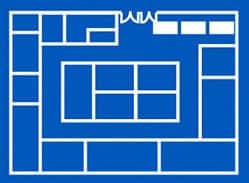 |
Free-flow/Mixed Floor Plans Used in specialty and boutique settings | Apparel, accessory, personal care, specialty brand, and mixed-use stores like bakeries that also display packaged goods | 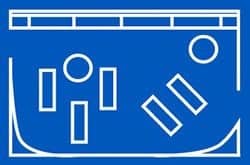 |
Diagonal Floor Plans Maximize employee visibility in retail stores with lots of product testing | Self-serve kiosks, tech and electronic stores, and beauty and cosmetics retailers | 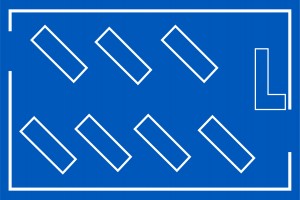 |
Forced-path Floor Plans Customers are guided through a predetermined path and exposed to every product | Furniture, home decor, and experiential retail stores and showrooms |  |
Angular Floor Plans Showcase curated or edited inventories in designer or specialty shops | Designers, artisans, high-end apparel and accessories retailers, and curated or limited collections | 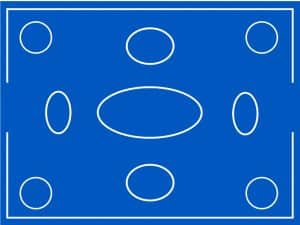 |
A well-positioned checkout will open up prime retail space for displaying products and encourage shoppers to move through more of your store. Instinct might tell you to place your checkout at the front of the store so that it’s most visible or on the right-hand side of your store where traffic tends to flow. But, the best place to position a retail checkout counter is often on the left side of a store.
Shoppers naturally veer toward the right side of a store when they walk inside. So, that’s where you want to display money-making products and new products. Some department stores and larger mall retailers place their checkout counters at the back of the store. However, for smaller retailers, placing your checkout toward the front makes it easier for staff to attend the register and keep an eye on the entrance.
This small-footprint retail store layout features a checkout counter on the left side of the store, with featured products displayed on the right side.
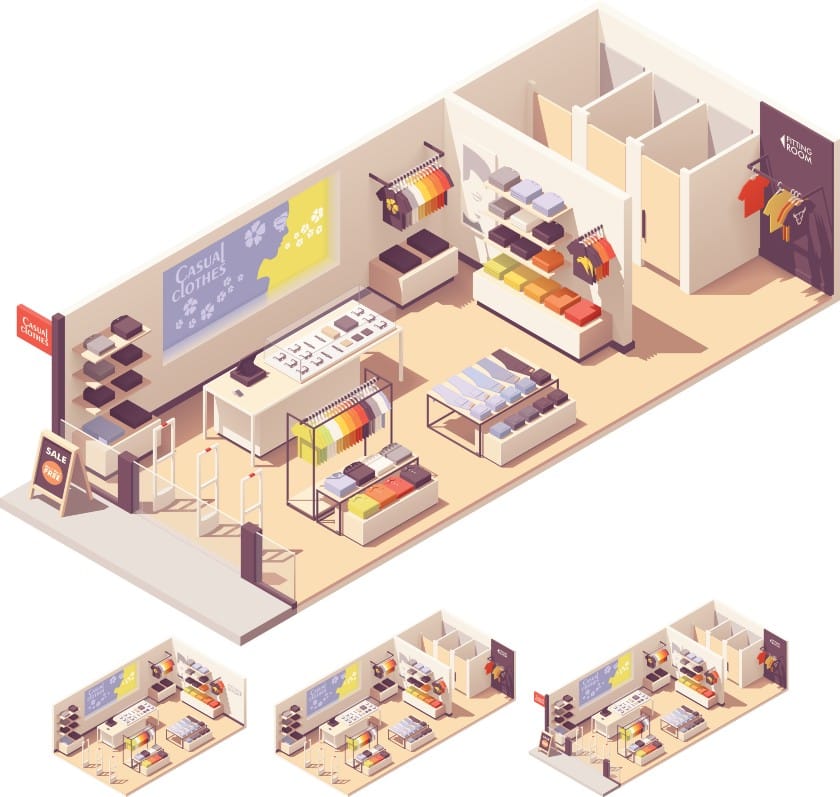
This small-footprint retail store layout features a checkout counter on the left side of the store, with featured products displayed on the right side.
Learn more about how to set up your checkout to drive sales.
Once you have the bones of your store layout and checkout counter placed, you’ll also need to invest in display fixtures, signage, and lighting. Start with parts of the store that will be mostly permanent: counters, lighting installations, dressing rooms, and any fixed shelving.
Because these pieces will be permanent, invest in high-quality items that will form a cohesive look and won’t fall out of trend. From there, you can outfit the rest of your store with more affordable, temporary merchandise displays and decorations that are easier to swap out with the seasons or trends.
Read our guides below for step-by-step instructions on setting different fixtures and displays:
- How to select and design retail lighting
- How to design the best storefront sign for your business
- Tips for great fitting room design
- Store design ideas for increasing sales
Exactly how you merchandise your products will depend on what type of store you have and the layout you choose. But there are a few simple tricks you can use to boost sales in any store environment.
- Eye level is buy level: Products placed at eye level instead of above or below are more likely to be seen and purchased.
- Place seasonal products and new arrivals front and center: Many retailers utilize a table display five to 15 feet inside the entrance that’s updated almost daily to show off new and limited products.
- Drive impulse sales at the point of purchase: Think candy at the grocery checkout; placing small, low-cost but useful or appealing items like phone chargers, Chapstick, and lottery tickets near the checkout counter is an effective way to drive add-on sales.
- Keep it comfortable: Shoppers who spend more time in your store also spend more money; encourage shoppers to stay awhile with Wi-Fi, product demos, and comfortable seating.
For more tips on how to merchandise your store, download our store layout e-book for step-by-step instructions.
Step 10: Choose & Install a Retail POS System
Another major piece of opening a retail store is selecting a point-of-sale (POS) system. Most basically, your POS system is the software that processes transactions and completes in-person sales. Modern POS systems, however, do much more than that, acting as the heart of all store management, including CRM, inventory, payment processing, ecommerce, reporting, vendor management, and more. Using a POS system will save you time, streamline all your management tools into one platform, and provide deeper insights into your business.
There are many factors to consider when selecting a POS. Before you start seriously considering different options, it’s important to write down a wish list of what features you want. Some of the criteria we use to evaluate the best retail POS systems include:
- Price: Most POS software programs charge a monthly fee, and some also charge extra for certain features like advanced inventory management.
- Setup and installation process: Some POS systems have a DIY installation process; others charge a hefty professional installation fee. You should also note the integration capabilities and process.
- Ease of use: Test out the POS to make sure the interface is comfortable to navigate; also, read user and expert reviews to be aware of any glitches or common problems.
- Inventory management: Make sure the retail inventory management solution you use has features to bulk upload orders, set stock alerts, and create purchase orders directly from the system to save you time.
- Customer management tools: Almost all POS systems have a customer directory feature, but otherwise, they vary greatly in what loyalty, marketing, and customer feedback features are included.
- Ecommerce functions: If you have plans to also sell online, make sure the POS you choose also has an online store feature so all of your inventory, customer, and order information syncs between online and offline sales.
- Payment processing: Some POS providers have built-in, in-house payment processors, and others let you integrate with third-party options for no fee.
For traditional brick-and-mortar stores, boutiques, and specialty shops, we often recommend Lightspeed. It’s a small business POS with big business functionality like custom report builders and advanced inventory management tools (such as built-in product ordering) and offers a sophisticated ecommerce platform.
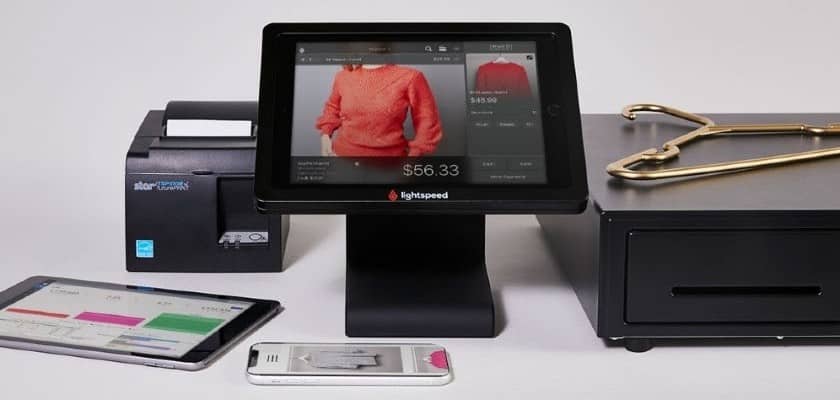
Lightspeed Retail POS (Source: Lightspeed)
Once you have a POS system selected, you need to choose a credit card processing company or merchant services provider. Some POS systems include their own in-house payment processing, while others require you to use a third party. The two most important things to consider when choosing a retail credit card processing company are price and compatibility with your POS.
When it comes to price, there are three main types of card processing fee structures:
- Flat rate: Processing companies charge a set percentage of the transaction; this is usually a good option for retailers such as convenience stores that have lower average sales (under $20).
- Interchange plus: Processing companies pass along the interchange fees from Visa, Mastercard, and similar payment processors and add a per-transaction fee on top; this is usually a good option for most established specialty shops.
- Tiered: Processors charge a different rate depending on the type of credit or debit card used in the transaction; we typically don’t recommend choosing a processor with this fee structure because it’s unpredictable and often more expensive.
Credit card processing fees can be notoriously murky and difficult to pin down. Our credit card processing fees guide defines common terms and breaks down different types of fees in detail.
Some card processing companies also charge monthly fees, and some have lengthier application processes than others. Many traditional merchant accounts also require contracts or have early termination fees. Be careful to read the fine print before signing with a card processing company.
The other thing to consider is whether or not the payment processor integrates with your POS system. Choosing a processor that integrates with your POS is ideal because as you ring up sales, they will automatically sync with your POS system’s sales data, inventory, and CRM. If you don’t have a payment processor that integrates with your POS, you have to input sales manually, and your data becomes susceptible to human error.
Read more about choosing the best retail credit card processors.
Step 11: Hire & Train Retail Staff
Last but certainly not least, you need to bring on a stellar group of employees to serve as the front lines of your business. If you haven’t hired an employee before, navigating the process can be really intimidating. Our new hire checklist outlines all of the gritty steps you need to take, such as obtaining an employer identification number (EIN), registering for state and local taxes, and so on.
As a small business retailer, it’s likely you won’t have a dedicated HR team member. And, hiring retail workers right now is especially challenging.
”We hear every day from our member companies—of every size and industry, across nearly every state—they’re facing unprecedented challenges trying to find enough workers to fill open jobs. Right now, the latest data shows that we have over 10 million job openings in the US—but only around 6 million unemployed workers”
– Stephanie Ferguson, Director at the Global Employment Policy & Special Initiatives, US Chamber of Commerce
With this knowledge, it’s more important than ever to take your hiring seriously. Take a look at our tips below and read more with our guide to retail recruiting to learn how you can overcome hiring challenges for your retail business.
The first step in writing an accurate and compelling job post is to create the job description for the position you are hiring, whether store associate or shift manager. Then, consider what qualities would be a best fit for the position. Finally, add in at the beginning of the post what your company is and why your future employees will love working there – including an attractive pay and commission structure.
In addition to using an all-in-one HR management tool, also consider using an applicant tracking system (ATS) to manage your search for the perfect candidates. An ATS is a software program that streamlines the hiring process and tracks candidates from initial job posting to hire. Here are a couple resources to help you find the right ATS tool for your new business:
Practice makes perfect with any skill, and customer service and store operations are no exception. You want your staff ready to deliver A+ service to your guests and shoppers from the minute your store opens, giving you peace of mind that they can handle store operations when you aren’t around. That’s where new hire training comes in.
You can also download our free opening and closing procedures checklists to provide to your staff. We recommend printing these lists and laminating them or keeping them in a clear sheet protector in a binder. Then associates can use expo markers to check things off each day and then erase the list at the end of the week for a fresh start.
Hold a paid training “boot camp” where you practice customer service skills, review store policies, outline expectations, and teach staff about the products in your store. Find ways to incorporate games and contests to keep the training engaging.
“Most of training is exposure; you tell them what to do, and they understand. But, until you commit to having a great sales process, in bite-sized lessons that you practice and role play, you won’t be able to hold employees accountable. Without accountability to execute that process every time, you’ll settle for whoever will work your shifts, you’ll cripple your ability to succeed, and invariably you’ll use the loser’s limp that Amazon was the reason you weren’t successful. Training isn’t something you did once—it’s something you do.”
– Bob Phibbs, CEO, The Retail Doctor retail consultancy
Step 12: Build Your Marketing Plan
Now that your brand and store are ready, it’s time to build a retail marketing strategy. Your marketing strategy should outline everything from your pre-launch initiatives to your store’s grand opening and the first few weekends post-launch. This will ensure that people know about your store upon opening and that you are able to continue to attract a healthy mix of new and repeat customers.
You’ve put in months, if not years, of hard work conceptualizing your store and building it from the ground up—a grand opening is a perfect opportunity to introduce your business to the community with a bang.
Some ideas you can consider to boost your grand opening are:
- Hand out unique promotional gifts
- Provide product or service discounts
- Host games and live music
- Invite the local news and influencers
- Partner with a local group or charity
Planning a party only to have no one show up is really disheartening and definitely not the tone you want to set for your new business. Make sure your event is well attended by recruiting friends and family, but also by starting your advertising efforts as soon as you have a date planned. Draft a press release to send to local media outlets and neighboring businesses. Create an event on Facebook. Take an ad out in the local paper. Go all out.
Need some inspiration for advertising your grand opening?
Learn how to write a grand opening press release.
Working with similar but non-competitive businesses, such as spas, fitness centers, and other types of retailers, is a great way to tap into a pre-existing customer base. By involving other businesses, you’ll spread the word about your store to their customers, too. Tap into your local chamber of commerce, networking groups, schools, and even youth sports organizations. Invite members from those groups to attend your grand opening festivities.
Step 13: Ensure You’re Compliant
Our final and possibly most important tip for starting a retail business is to ensure you’re fully compliant and legal. Be sure to comply with all local laws and regulations when opening a retail store, including but not limited to:
- Federal tax ID or EIN: Used to identify businesses for tax-paying purposes; this is a nine-digit number issued by the IRS that all employers need to apply for.
- Sales permit: Issued by the state and allows businesses to sell products and collect sales tax.
- Certificate of occupancy: Local government issues a certificate stating the building your business is inhabiting is up to code.
- Sign permits: Some local governments require permits for certain kinds of signage, like the one you may want to display on your storefront.
- Safety and health information bulletins: You may be required to display certain signage about employee rights or safety information; these are often provided to you, but it never hurts to check with your local government.
- Local COVID-19 mandates: Although these mandates are no longer as prevalent, you might be required to have a fully vaccinated team and put regular testing in place for those who are unvaccinated or enforce some type of mask-wearing rule.
If you’re unsure where to start or want to be sure you’re not missing any compliance aspects, check with your local town hall or municipal center and your local chamber of commerce.
Bottom Line
Opening a retail store takes years of planning. But, putting in the time to make a detailed plan and execute accordingly will set you on a path to success once your business is operational.
You May Also Like…
- Our ultimate guide to managing a successful retail store
- Learn what retail metrics you should measure and how to interpret them to keep your store on track
- Ready to grow? Here’s how to know when it’s time to open a second retail store
- Launch an effective retail commission structure for your store and staff

